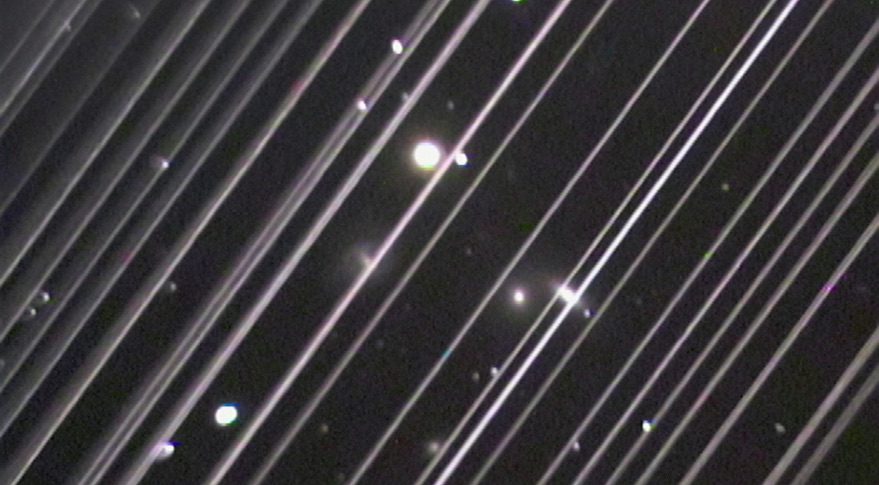WASHINGTON — A new report offers ways both astronomers and satellite developers can reduce the effect megaconstellations have on ground-based astronomy, but warned that no combination of measures can entirely eliminate the problem.
The report released Aug. 25 by the American Astronomical Society and the National Science Foundation’s National Optical-Infrared Astronomy Research Laboratory, or NOIRLab, is the outcome of a four-day workshop called Satellite Constellations 1 (SATCON1) held nearly two months ago. That workshop brought together more than 250 people, including both astronomers and satellite operators, to evaluate how to minimize the effect satellite constellations would have on astronomy.
For more than a year, astronomers have expressed concern that constellations of thousands of satellites could interfere with their observations. The satellites, visible through reflected sunlight, can leave bright streaks as they pass through the fields of view of telescopes.
The workshop concluded that while there are a number of ways to reduce the problem, there is no panacea. “No combination of mitigations will eliminate the impact of satellite constellations on optical astronomy,” said Connie Walker of NOIRLab, one of the co-chairs of the workshop, in an Aug. 25 press conference. The exception, she said, was not to launch such systems at all, but acknowledged “it’s not viable for industry.”
Instead, the report offered a set of recommendations to mitigate the effects of megaconstellations on astronomy, including ways for companies to reduce the brightness of their satellites and the amount of time they are visible in the night sky. Those steps include placing satellites in orbits no higher than 600 kilometers, as well as darkening them and controlling their attitude to reduce their reflectivity.
Even before the SATCON1 workshop, astronomers had been working with SpaceX on mitigation measures along the lines of those steps described in the report. The Starlink satellites operate at an altitude of 550 kilometers, and the company has tested measures to both darken the satellites to reduce their reflectivity as well as to install visors to block sunlight from hitting reflective surfaces.
The first “VisorSat” satellite launched in June and, earlier this month, reached its operational orbit. Astronomers said it was still too soon to measure its effectiveness. “We don’t have a complete set of observations yet,” said Lori Allen of NOIRLab, who chaired a SATCON1 working group on observations. “We do have some initial observations, but those are still under analysis.”
Allen said that the effort to measure the brightness of VisorSat had been affected by observatories that remain closed because of the pandemic. However, some amateur satellite observers have observed the first VisorSat this month and estimate its brightness at seventh magnitude, enough of a reduction to reduce the worst impacts on astronomy.
The efforts to reduce the brightness of Starlink satellites are much further along than those of other satellite constellations, such as OneWeb and Amazon’s Project Kuiper. OneWeb, which paused the deployment of its constellation after filing for Chapter 11 bankruptcy in March, worries astronomers because its satellites are in orbits 1,200 kilometers high, making them visible longer each night. The company also recently filed a proposal to operate as many as 48,000 additional satellites.
“SpaceX is leading the charge in terms of trying to understand these issues and designing mitigations on their satellites,” said Tony Tyson, chief scientist of the Vera Rubin Observatory and chair of a SATCON1 working group devoted to mitigation measures.
“Others are getting interested,” he added, notably OneWeb and Amazon, which participated in the workshop, “but we’re nowhere near any kind of down-to-earth engineering discussions on how to do this.”
The report included recommendations for astronomers as well, such as development of software to plan observations to avoid or minimize the number of satellites passing through the field of view, as well as software to identify and remove trails created by passing satellites. It also recommended astronomers and satellite operators work together to coordinate observations of satellites to measure changes in brightness over time, and to share more accurate satellite position data to enable astronomers to more effectively avoid satellites.
“We need to greatly increase the precision of publicly available positions” of satellites, said Jeff Hall of Lowell Observatory, the other co-chair of the SATCON1 workshop. “They’re not accurate enough for observatories to work around some of the issues that we’re facing.”
The report did not examine regulatory or policy issues involving satellite megaconstellations and astronomy. That will be the subject of a second workshop tentatively scheduled for the first half of 2021.
The SATCON1 workshop is not the only study of the topic. The NSF commissioned a report from the independent JASON scientific advisory group on the effects megaconstellations have on astronomy in general. Ralph Gaume, director of the NSF’s astronomical sciences division, said at an Aug. 25 meeting of the Astro2020 decadal survey steering committee that he received an initial “letter report” from the group a week ago, and expected the final report around Oct. 1.
Phil Puxley, vice president for special projects at the Association of Universities for Research in Astronomy, which operates NOIRLab for the NSF, noted at the SATCON1 briefing that astronomers previously built observatories in remote locations to avoid terrestrial light pollution. But with constellations, he said, “there are no remote locations that are immune. There is no place to hide.”
